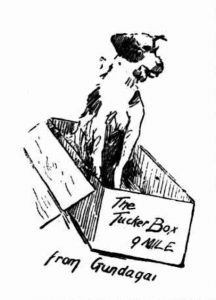[Editor: This article, about the dog on the tucker box, was published in The Gundagai Independent (Gundagai, NSW), 11 August 1932.]
The emblem of our big week
Monument where the dog sat
 There is not a person in the whole of Australia who has not heard of “the dog and the tucker box,” which is associated with the famous nine mile peg.
There is not a person in the whole of Australia who has not heard of “the dog and the tucker box,” which is associated with the famous nine mile peg.
Year upon year thousands of cards are sold, on which are printed Jack Moses’s poetry, and that author collects a royalty on each.
But before Jack Moses wrote his poem, the dog and the tucker box were well known.
This verse is part of the original:
“As I was going down Conway’s Gap,
I heard a maiden cry:
‘There goes “Bill the bullocky,”
Bound for Gundagai.
A better poor old — —,
Never earnt an honest crust,
A better poor old — —,
Never drug a whip through dust.’
’Twas there that Nobby broke the yoke,
And poked out the leader’s eye,
And the dog sat in the tucker box
Nine miles from Gundagai.”
A monument should be erected at the nine mile peg, dedicated to the pioneers and bullockys, who made the highways of to-day possible, and there should be an unveiling ceremony during the “Back to Gundagai Week.”
Here’s where the hospital will benefit. When a solid concrete structure is erected, a photo of the monument could be taken and placed on cards for sale, with a 2d. royalty for the institution.
To say that the monument would not pay for itself, and ever afterwards not bring in cash for the hospital, is wrong. The cards would sell, as the present ones are now selling. From 2000 to 4000 of the present cards are sold annually, and a 2d. royalty on 2000 cards would add over £16 per annum to the finances of the hospital.
Let us make the pilgrimage to the “Tucker Box,” and the unveiling of the monument, the big thing in connection with our “Back to Gundagai Week.”
Would any other town let slip the opportunity that is Gundagai’s? No — they would not. Now it’s up to us to see that one of the most historic spots in the Commonwealth, not only brings finance to our hospital, but is adorned with a monument that will forever be something to show that Gundagai has not forgotten its pioneers and bullockys, who made present day life possible.
Source:
The Gundagai Independent (Gundagai, NSW), 11 August 1932, p. 2
Editor’s notes:
— — = two em dashes (or a variant number of em dashes) can be used to indicate swearing, just as “****”, “$#*!”, “#$@&%*!”, or similar, can indicate swearing (a series of typographical symbols used to indicate profanity is called a “grawlix”); an em dash is an extended dash (also known as an “em rule” or a “horizontal bar”), being a dash which is as wide as the height of the font being used (em dashes can also be used in place of a person’s name, so as to ensure anonymity; or used to indicate an unknown word)
annum = (Latin) year
bullockys = (usually spelt “bullockies”) plural of bullocky: a driver of a bullock team
Commonwealth = the Commonwealth of Australia; the Australian nation, federated on 1 January 1901
d. = a reference to a penny, or pennies (pence); the “d” was an abbreviation of “denarii”, e.g. as used in “L.S.D.” or “£sd” (pounds, shillings, and pence), which refers to coins used by the Romans, as per the Latin words “librae” (or “libra”), “solidi” (singular “solidus”), and “denarii” (singular “denarius”)
’twas = (archaic) a contraction of “it was”
[Editor: Changed “posible” to “possible”; “annumn” to “annum”; “unveiling of the momument” to “unveiling of the monument”.]
Leave a Reply